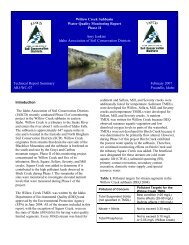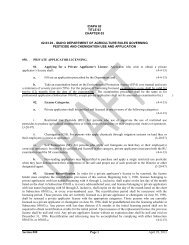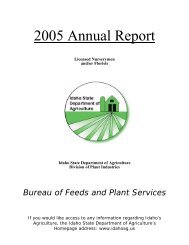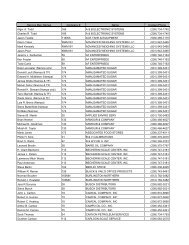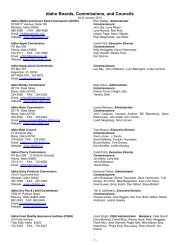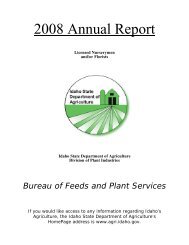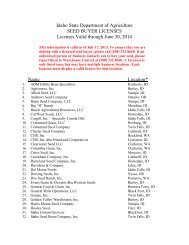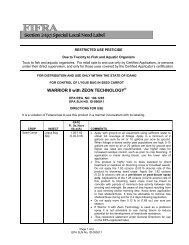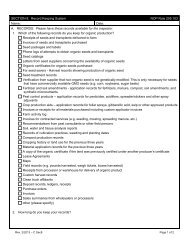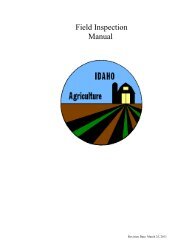2008 Statewide Strategic Plan for Eurasian Watermilfoil in Idaho
2008 Statewide Strategic Plan for Eurasian Watermilfoil in Idaho
2008 Statewide Strategic Plan for Eurasian Watermilfoil in Idaho
Create successful ePaper yourself
Turn your PDF publications into a flip-book with our unique Google optimized e-Paper software.
3. Fluridone<br />
Fluridone (Trade names <strong>in</strong>clude: Sonar® and Avast!®) is a slow-act<strong>in</strong>g systemic<br />
herbicide used to control <strong>Eurasian</strong> watermilfoil and other submersed plants. It may<br />
be applied as a pellet or as a liquid. Fluridone can offer excellent control of<br />
submersed plants where there is very little water movement and an extended time<br />
<strong>for</strong> plants to absorb the herbicide is allowed. Its use is most applicable to wholelake<br />
or isolated bay treatments where dilution is m<strong>in</strong>imized.<br />
S<strong>in</strong>ce fluridone <strong>in</strong>terferes with a susceptible plant’s ability to synthesize chlorophyll,<br />
symptoms of fluridone use are whitened leaves, retarded growth, and plant<br />
mortality. Effects of fluridone treatment are noticeable 7-10 days after application<br />
with control of target plants often tak<strong>in</strong>g 60-90 days to become evident. Because of<br />
the delayed nature of control, the herbicide is best applied dur<strong>in</strong>g the early growth<br />
phase of the target plant, usually spr<strong>in</strong>g or early summer.<br />
Lakes and ponds suitable <strong>for</strong> whole-lake fluridone treatments are heavily <strong>in</strong>fested<br />
with <strong>Eurasian</strong> watermilfoil throughout the littoral zone. Fluridone is not suitable <strong>for</strong><br />
spot treatments s<strong>in</strong>ce it is difficult to ma<strong>in</strong>ta<strong>in</strong> enough contact time between the<br />
plant and the herbicide to kill the weed. Fluridone is available <strong>in</strong> slow and fast<br />
release pellet <strong>for</strong>mulations to adapt treatment application strategies to water flow,<br />
depth, and control site parameters.<br />
Up to 100 percent of the <strong>Eurasian</strong> watermilfoil <strong>in</strong> a lake can be killed. However, <strong>in</strong><br />
<strong>in</strong>lets or areas where the herbicide may be diluted by flow<strong>in</strong>g water, <strong>Eurasian</strong><br />
watermilfoil may be under-treated and must be physically removed or treated with<br />
a contact-type herbicide <strong>for</strong> control to be successful. These areas should be<br />
identified dur<strong>in</strong>g plan development and additional methods should be evaluated<br />
and/or <strong>in</strong>tegrated <strong>in</strong>to the management strategy as warranted. For example; while<br />
<strong>Eurasian</strong> watermilfoil is under stress from a fluridone treatment, a contact-type<br />
herbicide like 2, 4-D or triclopyr may be applied at a lower rate than is typically<br />
required to provide additional control over large areas.<br />
The littoral zone of the lake should be thoroughly <strong>in</strong>spected by divers <strong>in</strong> the fall of<br />
the treatment year and the follow<strong>in</strong>g spr<strong>in</strong>g to identify any <strong>Eurasian</strong> watermilfoil<br />
plants that may have been under-treated. Susceptible areas <strong>in</strong>clude lake bottoms<br />
with spr<strong>in</strong>gs or near <strong>in</strong>let streams. Any rema<strong>in</strong><strong>in</strong>g <strong>Eurasian</strong> watermilfoil plants<br />
should be hand pulled or covered with bottom barriers. Inspections must cont<strong>in</strong>ue<br />
at least twice a year dur<strong>in</strong>g the grow<strong>in</strong>g season on an ongo<strong>in</strong>g basis. Survey work<br />
should be as frequent as can be af<strong>for</strong>ded, s<strong>in</strong>ce small <strong>Eurasian</strong> watermilfoil plants<br />
may be easily overlooked.<br />
4. Triclopyr<br />
Triclopyr (Trade names <strong>in</strong>clude Renovate and Renovate OTF). There are two<br />
<strong>for</strong>mulations of triclopyr. Triclopyr, applied as a liquid, is a relatively fast-act<strong>in</strong>g,<br />
systemic, selective herbicide used <strong>for</strong> the control of <strong>Eurasian</strong> watermilfoil and other<br />
broad-leaved species such as purple loosestrife. Triclopyr can be effective <strong>for</strong> spot<br />
36



